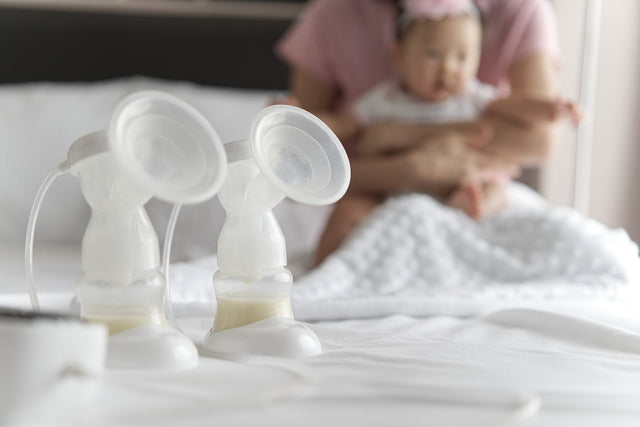10 Super Practical Tips to Make Pumping Suck a Little Less

Pumping breast milk is just part of the job for many new parents. But, for most, it’s not a job that sparks much joy…in fact, it can be a real drag. Even if pumping is a new, un-fun fixture in your life, there are ways to make it a little easier and more productive. Whether you’re exclusively pumping or are pumping at work to supplement breastfeeding, here are a few tips to take some of the suck out of pumping. (And if you haven't started pumping yet, here's what you need to know about getting a free breast pump!)
Find the right flange fit for your breast pump.
Though your breast pump probably came with a set of flanges (those funnel-like plastic pieces), they aren’t one-size-fits all. If you’re using the wrong size, pumping could be painful. It also might slow your flow. If you feel a tugging pain, your nipple looks white or red after pumping, your nipple is hitting the end of the flange, or the pump is pulling your areola into the flange, your flange might be the wrong size. Check with the manufacturer of your breast pump to determine if you should size up or down.
Master the art of hands-on pumping.
If you’re struggling with your milk output, breast massage or compression can help. A 2009 study found that when moms used their hands to express milk as they pumped, they pumped 48 percent more than they could have with the pump alone and the milk had about twice as much fat!
How to do hands-on pumping (here’s a video that shows the technique):
- Massage your breasts.
- Start pumping on both sides. As you pump, gently compress your breasts to help “milk out” the milk. Keep pumping until your milk flow decreases (usually for about 10 minutes).
- Massage your breasts again, if you feel any lumps, do a little more pumping on that side.
Invite your baby to your pumping session.
Put all of those adorable baby vids and pics on your phone to good use…looking at your baby’s cuteness can help get the juices (er…milk) flowing. Another way to boost your output: Pack some recently used swaddle blankets in your pumping bag so you can take a big inhale of that sweet new-baby smell.
Keep your eyes off the bottles when you pump.
This is one instance where it’s helpful to keep your eyes off the prize (aka the gradually accumulating liquid gold). If you’re having trouble producing, you may slow your flow if you stare at the bottles while pumping.
Do a little meditation or mindfulness practice while you pump milk.
Practice some relaxing deep breathing and pretend you are laying on the most beautiful beach without a care in the world. Or imagine your milk is flowing like a river to the sea.
Refrigerate your pump parts when you're in a pinch.
While ideally you'd give your pump parts a full scrub-down after each pumping session, sometimes that's not possible—whether you're in a time crunch or simply don't have access to the space and tools you need to properly clean and dry your equipment. When you do find yourself in a pinch, stash your unwashed pumping parts in a zip-top bag and keep them in the fridge until you need them again. (Pro tip: A cloth bag is less wasteful than a plastic baggie—and you can just toss it in the washing machine!) The cool temperatures of the fridge will stop bacteria in its tracks. At the end of the day, fully wash and sanitize your gear. Speaking of which…
Put your partner on breast pump clean-up duty.
Dads tend to be terrible at breastfeeding…but they make pretty good pump-part-cleaners! Make your partner responsible for washing, assembling, and packing your pump parts at home to lighten your load.
Schedule a multitasking morning pumping session.
Many pumping parents find their supply peaks in the morning. To take full advantage of this milk rush, try pumping off just a couple of ounces from one or both sides. Then, put the baby on to suck out the few ounces of rich hind milk that’s still inside. Your baby is a much more efficient milk-sucker than any pump! Don’t worry that your baby isn’t getting enough. Within a few days, your breasts will suddenly think you had twins (or triplets!) and will start making a few extra ounces for you every morning.
Spring for a mini fridge to store your pumped breast milk.
If you’re pumping at work, you can avoid awkward run-ins at the shared office fridge by keeping your own mini fridge. A small, 6-can fridge/cooler typically offers enough space for several bottles—and even a couple of flanges—for less than $50.
Start pumping now to build up a milk stash.
If you’re planning on pumping after you go back to work, don’t wait until then to begin! Get a head start by pumping now (try squeezing in a session between your normal feedings), so that you can stockpile milk in the freezer. This will take some of the pressure off once you return to the office! (Here's a guide to how long breastmilk is good—in the freezer, fridge, at room temperature—plus storage tips!)